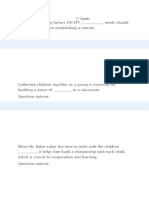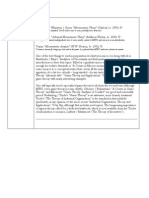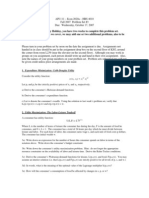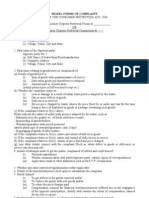Macroeconomics: Ninth Canadian Edition
Uploaded by
Uzma KhanMacroeconomics: Ninth Canadian Edition
Uploaded by
Uzma KhanMacroeconomics
Ninth Canadian Edition
Chapter 2
The Measurement and
Structure of the Canadian
Economy
Copyright © 2022 Pearson Canada Inc. 2–1
Main Questions
• How do we measure our current economic
activity?
• What is national income account?
• What are the relationships among key
macroeconomic variables
• How are the different sectors of the economy
related to each other?
Copyright © 2022 Pearson Canada Inc. 2–2
National Income Accounting (1 of 3)
• The national income accounts is an accounting
framework used in measuring current economic
activity.
• There are three approaches to calculate national
income.
Copyright © 2022 Pearson Canada Inc. 2–3
National Income Accounting (2 of 3)
• The product approach measures the amount of
output produced, excluding output used up in
intermediate stages of production.
– Value added = the value of output − the value of inputs
purchased from others.
Copyright © 2022 Pearson Canada Inc. 2–4
National Income Accounting (3 of 3)
• The income approach measures the incomes
received by the producers of output.
• The expenditure approach measures the amount
of spending by the ultimate purchasers of output.
Copyright © 2022 Pearson Canada Inc. 2–5
National Income Accounting Numerical
Example (1 of 3)
AppleInc Transactions
Wages paid to AppleInc employees 15,000
Taxes paid to government 5,000
Revenues received from the sale of 35,000
Apples sold to public 10,000
Apples sold to JuiceInc 25,000
JuiceInc Transactions
Wages paid to JuiceInc employees 10,000
Taxes paid to government 2,000
Apples purchased from AppleInc 25,000
Revenues received from the sales 40,000
Copyright © 2022 Pearson Canada Inc. 2–6
National Income Accounting Numerical
Example (2 of 3)
Product Approach
AppleInc value added 35,000
JuiceInc value added 15,000
Total Production 50,000
Income Approach
Wages income 25,000
Taxes paid to government 7,000
Profits 18,000
Total Income 50,000
Copyright © 2022 Pearson Canada Inc. 2–7
National Income Accounting Numerical
Example (3 of 3)
Expenditure Approach
Expenditures on apples 10,000
Expenditures on apple juice 40,000
Total Expenditures 50,000
Copyright © 2022 Pearson Canada Inc. 2–8
Why the Three Approaches Are
Equivalent (1 of 2)
• The market value of a good (product) and the
spending on a good (expenditure) are always the
same.
• The seller’s receipts (expenditure) are equal to the
total income generated by the economic activity
(income).
Copyright © 2022 Pearson Canada Inc. 2–9
Why the Three Approaches Are
Equivalent (2 of 2)
• Fundamental identity of national income
accounting:
total production = total income = total expenditure
Copyright © 2022 Pearson Canada Inc. 2–10
The Product Approach to Measuring
GDP (1 of 4)
• A nation’s gross domestic product (GDP) is the
market value of final goods and services newly
produced within a nation during a fixed period of
time.
• Using market values allows adding the production
of different goods and services.
Copyright © 2022 Pearson Canada Inc. 2–11
The Product Approach to Measuring
GDP (2 of 4)
• Problems with the market values:
– Some goods are not sold in markets.
– The underground economy – illegal activities and legal
activities hidden from the government.
– Lack of market values to use when calculating the
government’s contribution to the GDP.
Copyright © 2022 Pearson Canada Inc. 2–12
The Product Approach to Measuring
GDP (3 of 4)
• GDP includes only goods and services newly
produced within the current period. It is a sum of
value added – value of an output minus value of
its inputs.
• Intermediate goods are those used up in the
production of other goods in the same time period.
Copyright © 2022 Pearson Canada Inc. 2–13
The Product Approach to Measuring
GDP (4 of 4)
• GDP includes only final goods – not intermediate
goods, the end products.
• Capital goods and inventory investment are final
goods.
Copyright © 2022 Pearson Canada Inc. 2–14
GDP versus GNP (1 of 4)
• Gross national product (GNP) is the market
value of final goods newly produced by domestic
factors of production (capital, labour) during the
current period.
Copyright © 2022 Pearson Canada Inc. 2–15
GDP versus GNP (2 of 4)
• Canadian-owned capital and labour used abroad
produce output and income.
• This is included in Canadian GNP, not GDP.
• Foreign-owned capital and labour used in Canada
produce output and income.
• This is included in Canadian GDP, not GNP.
Copyright © 2022 Pearson Canada Inc. 2–16
GDP versus GNP (3 of 4)
• Net factor payments from abroad (NFP) is
– Income paid to domestic factors of production by the
rest of the world
– Minus income paid to foreign factors of production by
the domestic economy
Copyright © 2022 Pearson Canada Inc. 2–17
GDP versus GNP (4 of 4)
GDP + NFP = GNP
• In 2015 Canadian GDP was $1,983 billion and
Canadian GNP was $1,956 billion, a difference of
just over 1%.
Copyright © 2022 Pearson Canada Inc. 2–18
The Expenditure Approach to
Measuring GDP
Y = C + I + G + NX
Y = GDP
C = consumption
I = investment
G = government purchases of goods and services
NX = net exports of goods and services (exports
minus imports)
Copyright © 2022 Pearson Canada Inc. 2–19
The Expenditure Approach (1 of 3)
• GDP
– Total production or total income or total expenditure.
• Consumption (57.5% of GDP)
– Consumer durable goods
– Semi-durable goods
– Nondurable goods
– Services
Copyright © 2022 Pearson Canada Inc. 2–20
The Expenditure Approach (2 of 3)
• Investment (23.6% of GDP)
– Fixed investment
Residential construction
Nonresidential investment
Machinery and equipment
– Inventory investment
– Government investment
Copyright © 2022 Pearson Canada Inc. 2–21
The Expenditure Approach (3 of 3)
• Government purchases of goods and services
(21.2% of GDP)
– Government purchases, other than capital goods;
– Transfers
• Net exports of goods and services
(−2.3% of GDP)
– Exports minus imports, which in 2015 was negative
Copyright © 2022 Pearson Canada Inc. 2–22
The Income Approach to Measuring
GDP (1 of 3)
• Compensation of employees: (51.6% of GDP)
– Total remuneration, in cash or in kind, payable by an
enterprise to an employee in return for work done
• Gross operating surplus: (25.7% of GDP)
– Income earned from the production of goods and
services that is paid to the owners of incorporated
companies
– Dividends and other sorts of investment income
Copyright © 2022 Pearson Canada Inc. 2–23
The Income Approach to Measuring
GDP (2 of 3)
• Gross mixed income: (11.7% of GDP)
– Income paid to unincorporated enterprises.
• Taxes less subsidies on production:
(4.3% of GDP)
– Taxes (less subsidies received) that companies pay on
the use of labour, machinery, buildings, or other assets
used in the production of goods and services.
Copyright © 2022 Pearson Canada Inc. 2–24
The Income Approach to Measuring
GDP (3 of 3)
• Taxes less subsidies on products and imports:
(6.6% of GDP)
– Taxes payable after a product is produced and sold in
Canada or imported from abroad.
Copyright © 2022 Pearson Canada Inc. 2–25
Private Sector and Government Sector
Income (1 of 3)
• Private disposable income (PDI) is the amount of
income the private sector has available to spend
after paying taxes and receiving government
transfers.
Copyright © 2022 Pearson Canada Inc. 2–26
Private Sector and Government Sector
Income (2 of 3)
Private Disposable Income Y NFP T TR INT
Y = gross domestic product (GDP)
NFP = net factor payments from abroad
TR = transfers received from the government
INT = interest payments on the government’s debt
T = taxes
Copyright © 2022 Pearson Canada Inc. 2–27
Private Sector and Government Sector
Income (3 of 3)
Net Government Income T TR INT
TR = transfers received from the government
INT = interest payments on the government’s debt
T = taxes
Copyright © 2022 Pearson Canada Inc. 2–28
Saving and Wealth
• Wealth is the difference between assets and
liabilities.
• National wealth is the wealth of an entire nation.
• Saving is current income minus spending on
current needs.
Copyright © 2022 Pearson Canada Inc. 2–29
The Government Budget Surplus and
Budget Deficit
• The government budget surplus is a positive
difference between government revenue (T) and
government expenditure (G + TR + INT).
• The government budget deficit is a negative
difference between T and (G + TR + INT).
Copyright © 2022 Pearson Canada Inc. 2–30
The Uses of Private Saving
S Y NFP C G
(C I G NX ) NFP C G
I ( NX NFP )
I CA
CA is current account balance – payments received
from abroad for exports minus payments made to
foreigners for imports, NFP included.
Copyright © 2022 Pearson Canada Inc. 2–31
The Uses of Saving Identity
S S govt I CA S govt
S pvt I ( S govt ) CA
• Private saving is used in 3 ways
– Investment (I)
– Government budget deficit (−Sgovt)
– Current account balance (CA)
Copyright © 2022 Pearson Canada Inc. 2–32
Relating Saving and Wealth (1 of 2)
• Saving is a flow variable—a variable that is
measured per unit of time.
• Wealth is a stock variable—a variable that is
measured at a point in time.
Copyright © 2022 Pearson Canada Inc. 2–33
Relating Saving and Wealth (2 of 2)
• National wealth
– Country’s domestic physical assets
– Country’s net foreign assets =
country’s foreign assets – its foreign liabilities.
• National wealth can change through changes in
value of national saving (I + CA).
Copyright © 2022 Pearson Canada Inc. 2–34
Real GDP
• Nominal GDP (or current-dollar GDP) is the dollar
value of an economy’s final output at current
market prices.
• Real GDP (or constant-dollar GDP) is the physical
volume of an economy’s final output using the
prices of a base year.
Copyright © 2022 Pearson Canada Inc. 2–35
GDP Deflator (1 of 2)
• A price index is a measure of the average level of
prices for some specified set of goods and
services.
• The GDP deflator is a price index that measures
the overall level of prices of goods and services
included in GDP.
Copyright © 2022 Pearson Canada Inc. 2–36
GDP Deflator (2 of 2)
Nominal GDP
GDP Deflator
Real GDP
• The measurement of real GDP and the GDP
deflator depends on a choice of a base year.
Copyright © 2022 Pearson Canada Inc. 2–37
The Consumer Price Index
• The consumer price index (CPI) measures the
price of consumer goods.
• The CPI is calculated for a fixed consumer
“basket.”
• The basket should be occasionally updated or
chain-weighted indexes should be used.
Copyright © 2022 Pearson Canada Inc. 2–38
CPI and Inflation
• The rate of inflation is the percentage rate of
increase in a price index (the CPI, for example)
per a period of time.
Copyright © 2022 Pearson Canada Inc. 2–39
The Rate of Inflation
( Pt 1 Pt ) Pt 1
t 1
Pt Pt
πt+1 is the rate of inflation between t and t+1
Pt is the price level in period t
Pt+1 is the price level in period t+1
ΔPt+1 is change in the price level between t and t+1
Copyright © 2022 Pearson Canada Inc. 2–40
Real versus Nominal Interest Rates (1 of 2)
• An interest rate is a rate of return promised by a
borrower to a lender.
• We talk about “the” interest rate. Although they are
numerous, they move up and down together.
Copyright © 2022 Pearson Canada Inc. 2–41
Real versus Nominal Interest Rates (2 of 2)
• The real interest rate is the rate at which the real
value of an asset increases over time.
• The nominal interest rate (i) is the rate at which
the nominal value of an asset increases over time.
Copyright © 2022 Pearson Canada Inc. 2–42
Real Interest Rate
real interest rate i
i = nominal interest rate
π = inflation rate
Copyright © 2022 Pearson Canada Inc. 2–43
Expected Real Interest Rate
• The expected real interest rate (r) is the rate at
which the real value of an asset is expected to
increase over time.
r =iπ e
πe = an expected inflation rate
Copyright © 2022 Pearson Canada Inc. 2–44
You might also like
- [Ebooks PDF] download Essentials of Econometrics 5th Edition Damodar Gujarati full chapters100% (6)[Ebooks PDF] download Essentials of Econometrics 5th Edition Damodar Gujarati full chapters50 pages
- Employment Agreement ("Agreement") No 2977No ratings yetEmployment Agreement ("Agreement") No 29775 pages
- Chapter 5 Production and Cost Analysis in The Short Run Economics For Managers 3e FarnhamNo ratings yetChapter 5 Production and Cost Analysis in The Short Run Economics For Managers 3e Farnham24 pages
- ECS2602+2017+Macroeconomics Teaching Notes PDFNo ratings yetECS2602+2017+Macroeconomics Teaching Notes PDF166 pages
- Business and Economic Forecasting EMET3007/EMET8012 Problem Set 1No ratings yetBusiness and Economic Forecasting EMET3007/EMET8012 Problem Set 12 pages
- Principles of Microeconomics Problem Set 2 Model Answers50% (2)Principles of Microeconomics Problem Set 2 Model Answers6 pages
- International Economics, 7e (Husted/Melvin) Chapter 3 The Classical Model of International TradeNo ratings yetInternational Economics, 7e (Husted/Melvin) Chapter 3 The Classical Model of International Trade25 pages
- Download full (Original PDF) Macroeconomics, Eighth 8th Canadian Edition ebook all chapters100% (8)Download full (Original PDF) Macroeconomics, Eighth 8th Canadian Edition ebook all chapters46 pages
- Test Bank For Macroeconomics 8th Canadian Edition Andrew AbelNo ratings yetTest Bank For Macroeconomics 8th Canadian Edition Andrew Abel16 pages
- Zica Accountancy Programme: Macro Economics (Zica) AccountingNo ratings yetZica Accountancy Programme: Macro Economics (Zica) Accounting163 pages
- International Financial Management: by Jeff MaduraNo ratings yetInternational Financial Management: by Jeff Madura39 pages
- Fundamentals of Corporate Finance, 2/e: Robert Parrino, Ph.D. David S. Kidwell, Ph.D. Thomas W. Bates, PH.D100% (1)Fundamentals of Corporate Finance, 2/e: Robert Parrino, Ph.D. David S. Kidwell, Ph.D. Thomas W. Bates, PH.D56 pages
- Stock Watson 4E Exercisesolutions Chapter7 Students PDFNo ratings yetStock Watson 4E Exercisesolutions Chapter7 Students PDF6 pages
- PDF Test Bank for Public Finance: A Contemporary Application of Theory to Policy, 10 Edition : David N Hyman download100% (5)PDF Test Bank for Public Finance: A Contemporary Application of Theory to Policy, 10 Edition : David N Hyman download31 pages
- Calculus for Business Economics Life Sciences and Social Sciences 13th Edition Barnett Solutions Manual - Download Now And Never Miss A ChapterNo ratings yetCalculus for Business Economics Life Sciences and Social Sciences 13th Edition Barnett Solutions Manual - Download Now And Never Miss A Chapter66 pages
- International Economics - 9 Edition Instructor's ManualNo ratings yetInternational Economics - 9 Edition Instructor's Manual86 pages
- Chapter 6 Solutions Solution Manual Introductory Econometrics For FinanceNo ratings yetChapter 6 Solutions Solution Manual Introductory Econometrics For Finance11 pages
- MR Moyo - Economics Revision Demand and Supply Assignment 1 As100% (1)MR Moyo - Economics Revision Demand and Supply Assignment 1 As30 pages
- Macroeconomics IIA ECON20401: Paul MiddleditchNo ratings yetMacroeconomics IIA ECON20401: Paul Middleditch39 pages
- The Data of Macroeconomics: AcroeconomicsNo ratings yetThe Data of Macroeconomics: Acroeconomics54 pages
- Unit 23: Measuring A Nation'S Income (Ans)No ratings yetUnit 23: Measuring A Nation'S Income (Ans)5 pages
- Linear Models and Matrix Algebra: Alpha Chiang, Fundamental Methods of Mathematical Economics 3 EditionNo ratings yetLinear Models and Matrix Algebra: Alpha Chiang, Fundamental Methods of Mathematical Economics 3 Edition32 pages
- Department of Economics: Welcome To TheNo ratings yetDepartment of Economics: Welcome To The36 pages
- Chapter 4 Lecture Presentation - Part 1No ratings yetChapter 4 Lecture Presentation - Part 137 pages
- The Study of Personality: Assessment, Research, and TheoryNo ratings yetThe Study of Personality: Assessment, Research, and Theory28 pages
- All India Prelims Test Series - 2017: Indian Polity + GeographyNo ratings yetAll India Prelims Test Series - 2017: Indian Polity + Geography11 pages
- Caustic Recovery Plant Survey 2022-ACS TextilesNo ratings yetCaustic Recovery Plant Survey 2022-ACS Textiles3 pages
- The Diary of A Young Girl Mooyaart - Doubleday PDF: Traducir Esta PáginaNo ratings yetThe Diary of A Young Girl Mooyaart - Doubleday PDF: Traducir Esta Página2 pages
- A Thousand Splendid Suns: Khaled HosseiniNo ratings yetA Thousand Splendid Suns: Khaled Hosseini11 pages
- 16 Weeks Plan Pakistan Studies (PKS-101) Since 2022No ratings yet16 Weeks Plan Pakistan Studies (PKS-101) Since 20223 pages
- Final Electoral Roll Teachers of Aided Colleges Affiliated To UniversityNo ratings yetFinal Electoral Roll Teachers of Aided Colleges Affiliated To University121 pages
- Attack Proof The Ultimate Guide to Personal Protection 2nd ed Edition John Perkins - The full ebook version is available, download now to explore100% (2)Attack Proof The Ultimate Guide to Personal Protection 2nd ed Edition John Perkins - The full ebook version is available, download now to explore71 pages
- Đề Cương Giữa Kỳ i Tiếng Anh 12 Văn LangNo ratings yetĐề Cương Giữa Kỳ i Tiếng Anh 12 Văn Lang21 pages
- Edelweiss Passive Equity Deck - Edelweiss MFNo ratings yetEdelweiss Passive Equity Deck - Edelweiss MF75 pages
- ETX-5300A: Ethernet Service Aggregation PlatformNo ratings yetETX-5300A: Ethernet Service Aggregation Platform4 pages
- Zero Conditional - Safety Rules WorksheetNo ratings yetZero Conditional - Safety Rules Worksheet3 pages
- [Ebooks PDF] download Essentials of Econometrics 5th Edition Damodar Gujarati full chapters[Ebooks PDF] download Essentials of Econometrics 5th Edition Damodar Gujarati full chapters
- Chapter 5 Production and Cost Analysis in The Short Run Economics For Managers 3e FarnhamChapter 5 Production and Cost Analysis in The Short Run Economics For Managers 3e Farnham
- Business and Economic Forecasting EMET3007/EMET8012 Problem Set 1Business and Economic Forecasting EMET3007/EMET8012 Problem Set 1
- Principles of Microeconomics Problem Set 2 Model AnswersPrinciples of Microeconomics Problem Set 2 Model Answers
- International Economics, 7e (Husted/Melvin) Chapter 3 The Classical Model of International TradeInternational Economics, 7e (Husted/Melvin) Chapter 3 The Classical Model of International Trade
- Download full (Original PDF) Macroeconomics, Eighth 8th Canadian Edition ebook all chaptersDownload full (Original PDF) Macroeconomics, Eighth 8th Canadian Edition ebook all chapters
- Test Bank For Macroeconomics 8th Canadian Edition Andrew AbelTest Bank For Macroeconomics 8th Canadian Edition Andrew Abel
- Zica Accountancy Programme: Macro Economics (Zica) AccountingZica Accountancy Programme: Macro Economics (Zica) Accounting
- International Financial Management: by Jeff MaduraInternational Financial Management: by Jeff Madura
- Fundamentals of Corporate Finance, 2/e: Robert Parrino, Ph.D. David S. Kidwell, Ph.D. Thomas W. Bates, PH.DFundamentals of Corporate Finance, 2/e: Robert Parrino, Ph.D. David S. Kidwell, Ph.D. Thomas W. Bates, PH.D
- Stock Watson 4E Exercisesolutions Chapter7 Students PDFStock Watson 4E Exercisesolutions Chapter7 Students PDF
- PDF Test Bank for Public Finance: A Contemporary Application of Theory to Policy, 10 Edition : David N Hyman downloadPDF Test Bank for Public Finance: A Contemporary Application of Theory to Policy, 10 Edition : David N Hyman download
- Calculus for Business Economics Life Sciences and Social Sciences 13th Edition Barnett Solutions Manual - Download Now And Never Miss A ChapterCalculus for Business Economics Life Sciences and Social Sciences 13th Edition Barnett Solutions Manual - Download Now And Never Miss A Chapter
- International Economics - 9 Edition Instructor's ManualInternational Economics - 9 Edition Instructor's Manual
- Chapter 6 Solutions Solution Manual Introductory Econometrics For FinanceChapter 6 Solutions Solution Manual Introductory Econometrics For Finance
- MR Moyo - Economics Revision Demand and Supply Assignment 1 AsMR Moyo - Economics Revision Demand and Supply Assignment 1 As
- Linear Models and Matrix Algebra: Alpha Chiang, Fundamental Methods of Mathematical Economics 3 EditionLinear Models and Matrix Algebra: Alpha Chiang, Fundamental Methods of Mathematical Economics 3 Edition
- The Study of Personality: Assessment, Research, and TheoryThe Study of Personality: Assessment, Research, and Theory
- All India Prelims Test Series - 2017: Indian Polity + GeographyAll India Prelims Test Series - 2017: Indian Polity + Geography
- The Diary of A Young Girl Mooyaart - Doubleday PDF: Traducir Esta PáginaThe Diary of A Young Girl Mooyaart - Doubleday PDF: Traducir Esta Página
- 16 Weeks Plan Pakistan Studies (PKS-101) Since 202216 Weeks Plan Pakistan Studies (PKS-101) Since 2022
- Final Electoral Roll Teachers of Aided Colleges Affiliated To UniversityFinal Electoral Roll Teachers of Aided Colleges Affiliated To University
- Attack Proof The Ultimate Guide to Personal Protection 2nd ed Edition John Perkins - The full ebook version is available, download now to exploreAttack Proof The Ultimate Guide to Personal Protection 2nd ed Edition John Perkins - The full ebook version is available, download now to explore





























































































